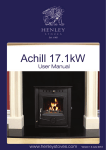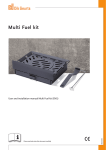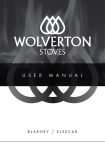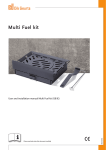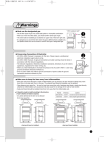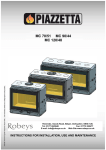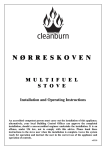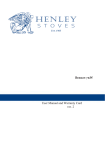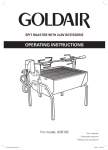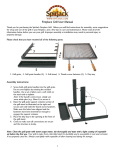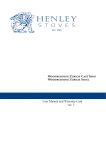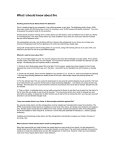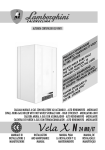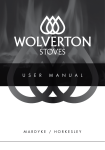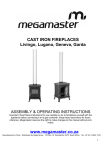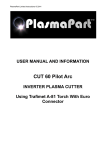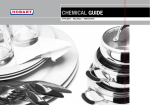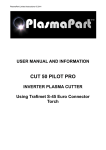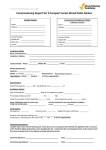Download Manual - Henley Stoves
Transcript
Version 2.0 May 2013 User manual COMPONENTS ASH PAN POKER HANDLE TECHNICAL SPECIFICATION Results of independent testing to EN 13229 Weight, 110 KG Nominal heat output, kW Nominal heat output to space, kW CO emission (at 13% O ), % 2 o Wood logs 7.7kW 7.7kW 76.3% 0.25 5.9 331 Distances to combustibles: Back Wall 900mm, Side Wall 700mm All local regulations, including those referring to national and European standards need to be complied with when installing the appliance. www.henleystoves.com User manual Congratulations on your purchase of a Henley Stove. With the proper care and attention your Henley stove will give you a lifetime of heat, comfort and pleasure. This manual contains instructions on how to install and maintain your Henley Stove. For both your comfort and safety please take the time to read through it carefully. ! www.henleystoves.com User manual Check that all firebox parts (grates, flue baffle) are correctly fitted and that the oscillating grates move correctly when operated Check the connection between the appliance and the chimney flue for air tightness (flue collar, blanking plates, loading doors, etc...) If a boiler model, check if there is enough water in the heating system and check the connections for water leaks After lighting up the stove, check if it operates correctly under fire, check for soundness of seals, leave the appliance operational with the heating system correctly balanced, hand over user instructions. For Wood Burning Only Only use the Tertiary Air vent when you are burning just wood fuel. The tertiary allows air into the stove from the base of the stove which is required for maximum combustion and efficiency for wood wood burning. www.henleystoves.com User manual HOW TO START A FIRE The Henley Druid 8 has 3 air vents which allow air into the stove to help ingite the fire in your stove. When starting your fire we recommend you open both the primary and secondary air vents fully to allow enough air to enter the stove the get the fire going. Open the tertiary air vent if you wish to burn only wood logs as wood needs air from below the fuel for maximum combustion and efficiency. Close the tertiary once the fire is burning strongly. Once the fire is lighting strongly you can close the primary air vent but we recommend you keep the secondary air vent open slightly as the fire will still require a small amount of air to continue lighting. If you keep the vents fully open it will cause the fire to burn fuel much quicker because the fire is getting too much air. Step 1. Step 2. Please note images are for illustration purposes and may not be the stove you have but contains the same features. www.henleystoves.com User manual Step 3. Step 4. Please note images are for illustration purposes and may not be the stove you have but contains the same features. www.henleystoves.com User manual Step 5. Please note images are for illustration purposes and may not be the stove you have but contains the same features. Questions I’m finding it very hard to light a fire in my stove? Why is this? 1. In some houses there may not be sufficient ventilation in the room for the fire to light effectively. You may need an additional air vent in the room to use the stove efficiently. The fire in my stove is burning out of control? Why is this? 1. Ensure you have both the primary and secondary air vents closed to stop air getting into the stove. 2. There may be a draught down the chimney which is causing too much air to get into the stove. We recommend you fit an anti down draught coil to prevent the down draught. What should I use to start my fire? 1. The best fuel to use to start the fire is well seasoned wood kindling sticks and some firelighters. Once the kindling sticks are lighting start adding fuel gradually until the fire is burning strongly. www.henleystoves.com User manual OPERATING INSTRUCTIONS ! Warning When properly installed and operated this appliance will not emit fumes into the dwelling. Occasional fumes from de-ashing and re-fueling may occur. Persistent fume emission is dangerous and must not be tolerated. If fume emission does persist: • Open doors and windows to ventilate room • Let the fire out and dispose of fuel from the appliance • Check for flue or chimney blockage, and clean if required • Do not attempt to relight the fire until the cause of the fume emission has been identified and corrected. If necessary seek expert advice. Note : It is recommended to use a fireguard in the presence of children, and also in the presence of old and/or infirm people Lighting the stove • Open the secondary (located to the top right of the stove) air intake fully by pushing the lever to the right. Open the primary intake fully (two wheels on the lower part of the door). • Use crumpled paper or firelighters and enough kindling wood to obtain a good fire bed. • Light the paper through the fuel retainer and close the loading doors. • Once the embers are glowing, load the firebox with solid fuel and close the doors carefully. • Once the fire is burning well, adjust the air intake damper to suit your required heat. • At first lighting, build up heat slowly to allow the appliance to be correctly “run in”. Note: The body of the stove may emit some fumes and give off a new paint smell for the first couple of hours. This is quite normal and you shouldn’t worry about it. Make sure the room is well ventilated during initial use. Recommended fuels: turf, briquettes, smokeless coal and wood. Maximum load 1.5-2kg. Re-fueling the stove Wood: • Open the secondary (top) air intake. Open the lower air intake. • Open the glass door and add logs. • To ensure clean burning when using wood, the secondary air control should be set at maximum for a couple of minutes immediately after refuelling in order to blacken the logs and establish flames. • Once flames are well-established, the control can be adjusted to the required setting. Re-fueling the stove on a low fire bed If there is insufficient burning material in the firebed to light a new fuel charge, excessive smoke emission can occur. Refuelling must be carried out onto a sufficient quantity of glowing embers and ash that the new fuel charge will ignite in a reasonable period. If there are too few embers in the fire bed, add suitable kindling to prevent excessive smoke. Fuel overloading The maximum amount of fuel specified in this manual should not be exceeded, overloading can cause excess smoke. Operation with door left open Operation with the door open can cause excess smoke. The appliance must not be operated with the appliance door left open except as directed in the instructions. Dampers left open Operation with the air controls or appliance dampers open can cause excess smoke. The appliance must not be operated with air controls, appliance dampers or door left open except as directed in the instructions. Please note on rare occasions there may be adverse weather conditions causing a downdraught in the chimney. If this occurs the appliance should not be used. www.henleystoves.com User manual Not recommended as fuel: • “Green wood. Green or damp wood reduces stove efficiency and makes the window, the internal walls and the flue dirty (soot, tar, etc.). • “Used timbers. Burning treated wood (railway sleepers, telegraph poles, off cuts of plywood or chip board, pallets, etc.) quickly clogs the flue ways (soot, tar, etc.), pollutes the environment (pollution and smell, etc.) and cause the fire to burn too quickly and overheat. “Green wood” and “recovered wood” can eventually cause a chimney fire. Prohibited fuel: Any form of bituminous coal or Petroleum based coke. The appliance should never be used as an incinerator to burn waste. Liquid fuels must not be used. Care of the stove It is advisable that the appliance is maintained regularly by a competent engineer. There should be no unauthorized modification of the appliance. If any parts need replacing then they should only be those recommended by the manufacturer. The appliance is not suitable for installation in a shared flue system. The appliance is capable of intermittent operation. It is important that furnishings and other combustible materials are not placed too close to the front of the fire. The safe distances for combustible materials to the rear and side of the appliance are 500 mm and 400 mm respectively. Chimney Cleaning The chimney and the connecting flue pipe must be swept a least once a year. Also remove any deposits from the oscillating grates, the firebox surfaces and the flue collar. Proper use of flues and regular maintenance and cleaning will prevent the build-up of soot and tars. In the event of a chimney fire, call the fire brigade, shut down the controls on the appliance (if safe to do so), move flammable materials, e.g. furniture, well away from the fireplace and chimney breast (again, if safe to do so) and evacuate the building. Please note: Burning large amounts of solely anthracite coal on a continuous basis will burn the grate out much quicker compared to using the recommended fuel. We recommend you a mixture of fuels such as turf, briquettes, smokeless coal and wood. Not cleaning the grate after every fire will result in the grate burning out prematurely. There must be no unauthorised modification of the appliance. Use only replacement parts recommended by the manufacturer. HOW TO USE THE RIDDLE GRATE. www.henleystoves.com User manual MAINTENANCE The appliance, flue gas connector and chimney should be cleaned regularly to avoid the build-up of soot and deposits. They should also be checked for blockage after a long period of shutdown, e.g. a bird may have nested in the chimney since it was last used. It is essential to keep the grate free from a heavy build up of ashes. The stove is equipped with a grate riddling device which is used to “shake” ashes off the grate into the ash pan. Whenever the stove is burning without life when the lower air intake is open, use the riddling tool to clear the grate of surplus ashes. If burning solid fuel, always empty the ash pan at least once a day or whenever it is full of ashes. Never allow the ash-pan to overfill allowing ash to be in contact with the underside of the grate. If this condition is allowed, the grate will wear out prematurely. The firebricks should be checked occasionally. It’s perfectly normal for the bricks to crack due to the intense heat, this will not affect the heat output of the stove. Fire cement can be placed on the bricks to prevent the brick from disintegrating. But if the bricks disintegrate, this will reduce insulation therefore causing loss of heat. Please note: Burning large amounts of soley anthracite coal on a continuous basis will burn the grate out much quicker compared to using the recommended fuel. We recommend you a mixture of fuels such as turf, briquettes, smokeless coal and wood. Not cleaning the grate after every fire will result in the grate buring out prematurely. Any stove fitted without the legs will result in the warranty being void. Care of the stove Do not use abrasive cleaners. Use a dry lint free cloth or a soft bristle brush. Cleaning the Glass Any deposits on the glass should clear when the stove is fired high. If there is any soot or tar left, first do wait until the glass is cool, clean with a proprietary stove glass cleaner. Do not use abrasives cleaners. The glass will resist temperature up to 750°C. Do not replace broken-glass with substitute materials. Consult your local Henley Stove Supplier for information on replacing glass. Chimney Cleaning The chimney and the connecting flue pipe must be swept a least once a year. Also remove any deposits from the oscillating grates, the firebox surfaces and the flue collar. FAQ’s Why is there no heat from my stove? 1. If your stove is installed in an alcove, you need to cap off the area directly above the stove by installing a 3mm mild steel plinth with insulation to prevent the heat from escaping. 2. If the fire continues to consume large amounts of fuel you may need to check the baffle plate is fitted correctly and also if there is too much of a draw up the chimney. 3. A simple test would be to open the door of the stove when it is not lighting and listen to see if you can hear wind in the chimney. If so this means you will need to install a damper in the flue to prevent the up draught. We recommend you contact a piping specialist and install an anti-up draught cowl. Why is my boiler stove not heating my radiators? 1. Please ensure the plumbing is done correctly. The boiler stove should be plumbed using the diagonal connections. If the stove is plumbed incorrectly it will not heat the radiators. 2. You should have a thermostat installed in your hot press which should be set to 55 degrees. We recommend you use a qualified plumber. www.henleystoves.com User manual FAQ’s I’m finding it very hard to light a fire in my stove? Why is this? 1. In some houses there may not be sufficient ventilation in the room for the fire to light effectively. You may need an additional air vent in the room to use the stove efficiently. There is smoke coming out of the stove when I light it, why is this? 1. To ensure maximum efficiency and to prevent the stove from smoking, the pipe at the back to the stove must be max 150mm before the 45 degree bend in the pipe, otherwise the smoke will not be able to escape up the chimney. 2. Stoves that are installed in flat roof houses or extensions may have this issue due to the structure of the building. It may also be because the chimney of your house is lower than the highest point of your roof which causes the wind to funnel down the chimney. We recommend you install a rotary cowl to resolve the issue. We recommend you get your stove installed by a professional. Can I light my boiler stove if my pipes are frozen? 1. No. Do not light a fire if it is suspected that any part of the water system is frozen or if there is not enough water in the heating system. The pipes need to thaw naturally. Why is the glass on the door of my stove dirty? 1. Simply open the airwash and pull the lever to the open position and open the primary. The airwash is normally located above the door of the stove. The glass will become visibly clean. Please note the glass with become visibilly dirty when the fire stops. You may wash the glass when the stove has cooled down. We recommend you always leave the airwash half open. My grate has already burned out, how come? 1. Burning large amounts of soley anthracite coal on a continuous basis the grate will burn out much quicker compared to using the recommended fuel. We recommend you a mixture of fuels such as turf, briquettes smokeless coal and wood. 2. Not cleaning the grate after every fire will result in the grate buring out prematurely. How often should I clean my chimney? 1. The chimney and the connecting flue pipe must be swept at least once a year. Ensure you remove any deposits from the oscillating grates, the firebox surfaces and the flue collar. We recommend you clean your chimney twice a year. What should I use to clean my stove? 1. Use a dry lint free cloth or a soft bristle brush. Do not use abrasive cleaners. Can I use my stove the day it is installed? 1. Yes. For the first 3 days you should only light small fires using small wood sticks to break in the stove. Register for your 5 year warranty online at www.henleystoves.com www.henleystoves.com User manual Parts If you require any other parts which are not mentioned below, contact your local Henley Stockist. Replacement Grate Replacement Baffle Plate Replacement Fire Bricks Replacement Door Glass Replacement Door Handle Replacement Ash Pan Please note the images above are for illurtration purposes only and may not look like the part in your stove. www.henleystoves.com












